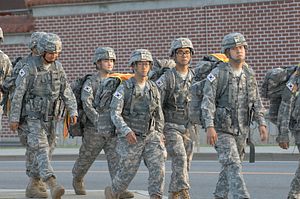On Monday, representatives from the United States and South Korea met in Seoul to discuss the conditions under which the wartime control of South Korean troops would be transferred from Washington to Seoul. According to Yonhap News, “ the meeting follows last month’s agreement between Seoul’s Defense Minister Kim Kwan-jin and his U.S. counterpart, Chuck Hagel.” Monday’s meeting took place at the assistant secretary level. An anonymous South Korean defense ministry official described the meeting’s primary purpose as being “in-depth discussions to set the timing and conditions for the South’s regaining of the wartime operational control (OPCON).”
According to the road map agreed upon by Chuck Hagel and Kim Kwan-jin, the United States and South Korea will consult on the issue on a monthly basis until October 2014. On Monday, the South Korea delegation was led by Ryu Je-seung, chief of the Defense Ministry’s planning and coordination office, and David Helvey, deputy assistant secretary of defense for East Asia of the United States, according to the Shanghai Daily.
Operational control is a major outstanding issue in the important U.S.-South Korea military alliance. In the wake of the Korean War, South Korea effectively granted operational control of its armed forces to the United States. In 1994, the two allies agreed that South Korea would control its troops during peacetime. In the event of a conflict with North Korea, the defense of the South Korean peninsula will be managed by U.S. commanders. Following two postponements since 2007, South Korea is currently scheduled to regain wartime control of its forces in December 2015. The current talks are intended to push that date back further.
The current round of talks were precipitated by a request from Seoul to delay the OPCON transfer after a series of provocative gestures and rhetorical pronouncements by North Korea last year. South Korea President Park Geun-hye and U.S. President Barack Obama mutually agreed in April to revisit the issue of OPCON transfer. Yonhap notes that during the latest round of talks “the allies also talked about the Korea Air and Missile Defense (KAMD) system and the Kill Chain pre-emptive strike system.”
These two systems have come to sit at the center of South Korea’s military deterrence policy. South Korean President Park Geun-hye emphasized them during her speech on South Korea’s Armed Forces Day last year: “The government will maintain a strong ROK-US combined defense system and secure early on the ability to respond to nuclear weapons and weapons of mass destruction by establishing the Kill Chain (an integrated information, surveillance, and strike system) and the Korea Air and Missile Defense (KAMD) system.” The “Kill Chain” has also been emphasized as crucial for South Korea’s preemptive deterrence strategy by South Korea Admiral Choi Yun-hee, the current chairman of the ROK’s Joint Chiefs of Staff.
In a post last year on SinoNK, Christopher Green summarizes the basic strategic logic of South Korea’s “Kill Chain” (paraphrasing Choi Jong-kun of Yonsei University):
Green adds that Choi “is entirely unconvinced that all or any of this is possible.” The main hurdle appears to be reconnaissance and real-time intelligence gathering. It seems that despite President Park and Admiral Choi’s support, South Korea acknowledges its shortcomings in this area and thus is keen to delay the U.S. OPCON transfer for a few more years.
Currently, experts see a real possibility that OPCON transfer could be pushed back as far as 2020 given the continued potential for an inter-Korean conflict. As long as South Korea’s KAMD and Kill Chain pre-emptive strike system remain in development, full OPCON transfer will likely be postponed. South Korea has been gradually developing a robust ballistic missile defense (BMD) capability through a combination of imports and indigenous missile defense development.

































